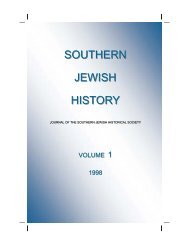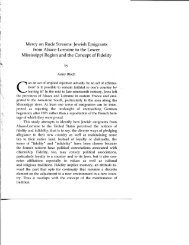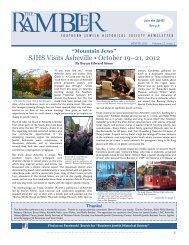A Shtetl Grew in Bessemer - Southern Jewish Historical Society
A Shtetl Grew in Bessemer - Southern Jewish Historical Society
A Shtetl Grew in Bessemer - Southern Jewish Historical Society
Create successful ePaper yourself
Turn your PDF publications into a flip-book with our unique Google optimized e-Paper software.
26 SOUTHERN JEWISH HISTORY<br />
other life cycle rituals cont<strong>in</strong>ued, without the stability and <strong>in</strong>spiration<br />
of a regular rabbi and with the other social and economic<br />
factors that were adversely affect<strong>in</strong>g <strong>Bessemer</strong>, the younger generation<br />
of Jews left <strong>in</strong> <strong>in</strong>creas<strong>in</strong>g numbers, thereby mak<strong>in</strong>g it<br />
difficult for the rema<strong>in</strong><strong>in</strong>g congregation to support the synagogue<br />
or pay a rabbi. 120 Temple Beth-El never aga<strong>in</strong> had a regular rabbi.<br />
The exodus, however, had actually started prior to Gall<strong>in</strong>ger’s<br />
resignation. From the 1940s through the 1960s, many of<br />
<strong>Bessemer</strong>’s <strong>Jewish</strong> youth left for college or enlisted <strong>in</strong> the military<br />
and never moved back. 121 Others, especially women, moved away<br />
when they married. 122 Still others moved from <strong>Bessemer</strong> to Birm<strong>in</strong>gham<br />
for bus<strong>in</strong>ess and/or the allure of a larger and more<br />
diverse sett<strong>in</strong>g with a <strong>Jewish</strong> populace sufficient to support three<br />
congregations and a <strong>Jewish</strong> community center. 123 As Jerry Cherner<br />
put it, “Birm<strong>in</strong>gham <strong>in</strong> the 1950s became more and more a place<br />
for socializ<strong>in</strong>g, for try<strong>in</strong>g to meet people, and for participat<strong>in</strong>g <strong>in</strong><br />
<strong>in</strong>teraction with <strong>Jewish</strong> people of your same age.” 124 Those who<br />
came of age <strong>in</strong> <strong>Bessemer</strong> <strong>in</strong> the 1920s and 1930s, who raised families<br />
there, and who thus chose to live the rema<strong>in</strong>der of their lives<br />
there, like Buddy Sokol, witnessed the migration of their own<br />
children and felt the angst of watch<strong>in</strong>g <strong>Jewish</strong> life <strong>in</strong> <strong>Bessemer</strong><br />
collapse:<br />
When I came to <strong>Bessemer</strong> <strong>in</strong> 1933, there were about thirty-eight<br />
<strong>Jewish</strong> families. Our temple was successful; we were able to get<br />
our services on a regular basis. But as my family grew up, we<br />
slowly lost men through death, or mov<strong>in</strong>g out of town. As our<br />
kids grew up, Murray [his eldest son] went to The University of<br />
Alabama <strong>in</strong> Tuscaloosa <strong>in</strong> the mid-1960s, and we got to where <strong>in</strong><br />
order to get a m<strong>in</strong>yan we had to ask him and later our other son,<br />
Jerry, to come home from college to make the ten needed. And<br />
so th<strong>in</strong>gs depreciated enough to where we had trouble even<br />
hav<strong>in</strong>g a service. Today <strong>in</strong> the Conservative movement you can<br />
count women <strong>in</strong> your m<strong>in</strong>yan, but then you couldn’t. So both<br />
Murray and Bruce We<strong>in</strong>ste<strong>in</strong> [Hyman’s son] would leave college<br />
on Friday afternoon to be home for services on Friday night.<br />
They didn’t want to come, but because their fathers were so







